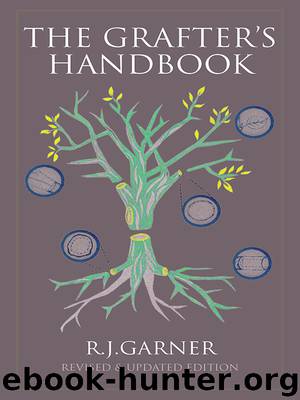The Grafter’s Handbook by R. J. Garner

Author:R. J. Garner
Language: eng
Format: epub
Published: 2013-02-11T16:00:00+00:00
Fig. 46 Prong budding
A. The incised rind of the stock is lifted by the spatula end of the knife. B. The spur or prong cut from the scion wood. C. The prong inserted and the stock rind held down by a large-headed nail. All incisions should be sealed. D. Thick rind pared down before inserting the prong in a long vertical slit. E. Slits in the stock rind to release tension in the region of the graft.
AFTERCARE OF BUD GRAFTS
The stock should be maintained in a healthy state by good cultivation, particularly in nurseries, for growth from the bud largely depends upon the vigour and health of the stock. The growth of the stock above the bud should not be reduced by pruning until the time comes to force growth from the scion.
Most tree species exhibit a powerful apical dominance so that growth from the newly-placed scion-bud is suppressed. Only by removing or checking the upper dominating growth can the scion be forced into activity and so become the trunk and branches of the new tree. Buds inserted in the early part of the growing season may be brought into growth that same season by removing, usually gradually, the leafy shoots of the stock. With small stocks that are easily bent, it is often sufficient to bend the stock so that the bud is at the top of the curved stem. On a small scale, rods or iron pipes may be laid on the bushy heads of the stocks to hold them in position. When the scions have made good growth and have well-expanded leaves, the stocks are cut through immediately above the buds. The wound may, with advantage, be smeared with sealing material to prevent drying of tissues close to the scion.
New buddings may be forced by removing a ring of rind from around the stock immediately above the inserted bud. Half-rings on the budded side often attain the same end without destroying the upper part of the stock.
The luxuriant shoots on fan-trained peaches and nectarines, which are often barren, may be furnished with fruiting laterals by budding and temporarily constricting the stock in the following manner76. As early as practicable in June, buds are inserted and the stock above is bound with raffia or soft twine. The bud is then tied in the normal manner. When the bud has taken it is unbound, but the upper tie is left until the bud has grown out about 100mm (4in), when it too is removed.
Normally, buds inserted during one growing season are not encouraged to grow out until the following season.
Tying materials which do not break or expand as the stock thickens should be cut or removed before severe constriction occurs. With some subjects it is necessary to retie to prevent the stock rind from curling back from the scion. This retying need not be so thorough as in the first instance, so long as it keeps the rind in position.
Stocks containing buds which have remained dormant until the winter are usually cut down to the bud soon after midwinter.
Download
This site does not store any files on its server. We only index and link to content provided by other sites. Please contact the content providers to delete copyright contents if any and email us, we'll remove relevant links or contents immediately.
On Writing A Memoir of the Craft by Stephen King(4863)
The Doodle Revolution by Sunni Brown(4687)
A Simplified Life by Emily Ley(4099)
Mummy Knew by Lisa James(3634)
Marijuana Grower's Handbook by Ed Rosenthal(3622)
Better Homes and Gardens New Cookbook by Better Homes & Gardens(3525)
Figure Drawing for Artists by Steve Huston(3381)
Paper Parties by Erin Hung(3371)
Draw Your Day by Samantha Dion Baker(3290)
The Genius of Japanese Carpentry by Azby Brown(3224)
Japanese Design by Patricia J. Graham(3110)
The Code Book by Simon Singh(3074)
Dangerous Girls by Haas Abigail(2979)
Lions and Lace by Meagan Mckinney(2925)
The Curated Closet by Anuschka Rees(2915)
How to Make Your Own Soap by Sally Hornsey(2829)
The Checklist Manifesto by Atul Gawande(2779)
The Wardrobe Wakeup by Lois Joy Johnson(2733)
Zero to Make by David Lang(2726)
